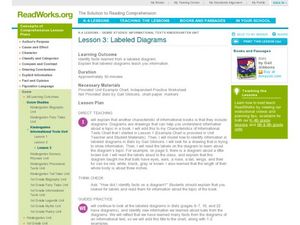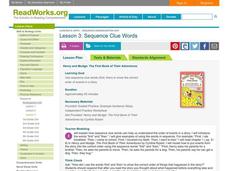Curated OER
Real and Make Believe
Young readers sort pictures into real and make believe categories. In this real and make believe lesson plan, students have a discussion about things that are real and things that are make believe.
Curated OER
Substituting Nouns
Let's practice substituting pronouns for nouns! In this writing sentences lesson, learners identify nouns and pronouns and replace the underlined examples. They complete a worksheet which are provided by grade level.
Curated OER
Lesson 3: Tells a Story
Kindergartners listen to a nursery rhyme and then tell the story in their own words (without rhyming). They practice as a class using Jack and Jill and then try Three Blind Mice on their own. The lesson plan includes a worksheet for the...
Curated OER
Sorting Into Predetermined Groups
Sort pictures of items into categories of at school and at the grocery store in a classification lesson plan. Kindergartners start by sorting pictures into categories of in the sky and in the ocean. Use the lesson for any story or unit...
Curated OER
Creating Groups and Sorting
Students practice classifying. In this classifying and oral language lesson, students listen to the story My Big Truck Book by Roger Priddy and identify similarities between the trucks described. Students sort the children in their class...
Curated OER
Similarities and Differences in a Text
Create a T chart of similarities and differences between the past and present from the story Long Ago and Today. Using their handy T chart, youngsters will chart things that are the same or different today and long ago. They'll draw a...
Curated OER
Lesson 2: Fiction
What makes a book fiction or nonfiction? Kindergartners discover ways to find out if a book is real or made up. They examine a fictional picture book as a group and decide what clues help them decide. There is an independent worksheet...
Curated OER
Lesson 2: Important Person
What kid wouldn't love to learn about George Washington? The class reads a simplistic biography about George Washington to find out why he is so famous. They chart the things he did, as well as what makes a non-fiction book a biography....
Curated OER
Labeled Diagrams
Let's learn about bats! Those flying creatures of the night inspire a instructional activity about non-fiction books. They start by charting characteristics commonly found in informational texts, specifically charts, diagrams, and...
Curated OER
Step By Step Directions
Perfect for your unit on pumpkins and autumn! Learn how to write step by step directions on how to dry pumpkin seeds based on The Pumpkin Book. Youngesters also explain how they know this is a "how to" book. A fun and yummy lesson!
Curated OER
Using Details To Create a Title
Learners read a book about leopards and create a title based on the details they read about the book. In this titles lesson plan, students read the book In the Wild: Leopards with the title covered up.
Curated OER
Sequence Clue Words
Young learners use sequence words to describe pictures they draw of events happening in a story. To practice sequencing events, they use words such as first, then, next, and more.
Curated OER
Causes
Things usually don't happen without a reason; usually any event has a cause that got the ball rolling. The book, If You Give a Mouse a Muffin is used to help learners understand the concept of causes in literature. Examples from the...
Curated OER
Identifying Problems and Solutions in the Story
Students explore story structure. In this Groundhog's Day story structure literacy lesson, students listen to the story Groundhog Stays Up Late by Margery Cuyler, then pause half way through the story to identify the problem and...
Curated OER
Lesson 1: Real People
A biography is a factual book or narrative about a real person. The book, The Story of Ruby Bridges is used to introduce non-fiction texts about real people and event to a Kindergarten class. A chart is used to highlight text features...
Curated OER
Humorous Solutions
Discover with your class the humorous solution that follows tall tales. Elementary learners will discuss the tall tale Paul Bunyan and give ordinary solutions for the problems in the story. They will read Sally Ann Thunder Ann Whirlwind...
Curated OER
Characters
Bring a lesson on nursery rhymes to your kindergarten class room. Kids listen to Three Blind Mice and identify the characters. They then decide which parts of the story make it a nursery rhyme. For extra practice, use the same activity...
Curated OER
Repeated Text
Students examine repeated text to predict the outcome of a story. In this language arts lesson, students read a story and use the repeated language to make predictions about what will happen next in the story.
Curated OER
Physical Attributes
Practice describing the physical attributes of story characters. After listening to a story, kindergartners identify each of the characters. They then draw a picture of the characters from the book.
Curated OER
What the Book is Mainly About
Students analyze the title, text, and pictures to determine the main idea. In this language arts lesson, students predict the main idea by looking at various features of the book. As students listen to the story, they illustrate and...
Curated OER
Identifying the Problem and the Solution in a Story
Story elements: the problem and the solution. Help your youngsters identify these elements by reading Bringing Down the Moon, by Jonathan Emmett. After a class discussion and chart creation discussing problems and solutions from past...
Curated OER
Identifying the Solution in a Story
Using the book My Red Balloon by Eve Bunting, Kindergartners will gain an understanding that stories often have solutions. Using Eve Bunting's book as an example the teacher will identify the solution to the story and walk the students...
Curated OER
Beginning and End
Are you working onevent sequence in your kindergarten class? Use a reading activity to have your kids discuss events from the story, and put them in order. They then cut and paste them in the correct order. A great project for any story!
Curated OER
Identifying What is Different
What is the same, what is different, and what does it all mean? Introduce the concept of identifying similarities and difference to your Kinder class using the I do, we do, you do, instructional approach. You'll provide structured...

























